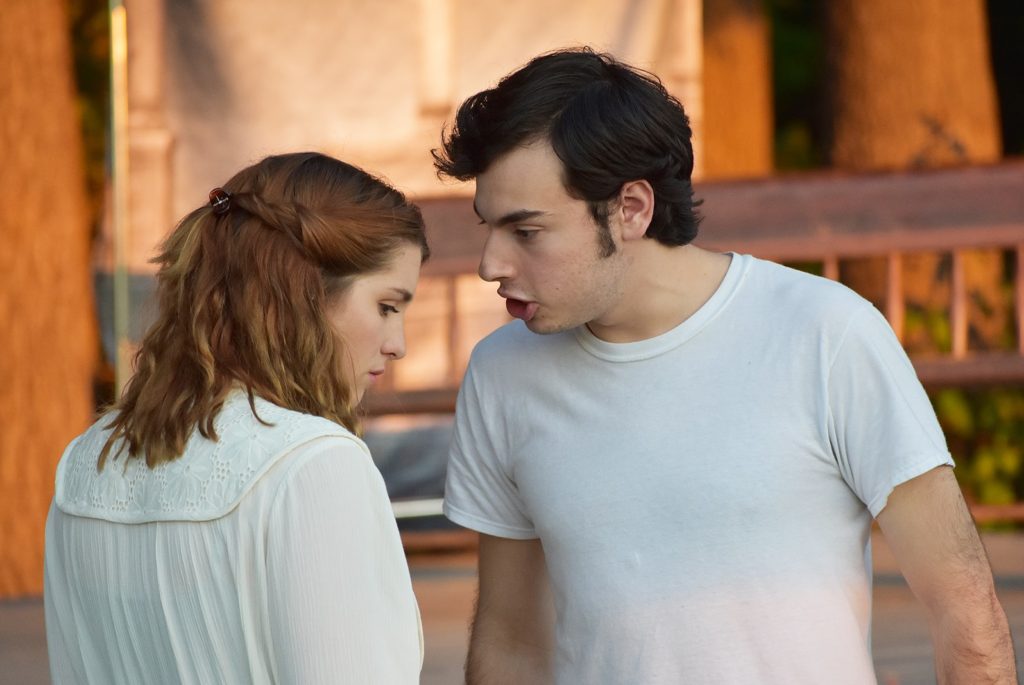Think of Rosencrantz and Guildenstern Are Dead as fan fiction – Tom Stoppard’s contribution to the “greatest-play-ever-written” phenomenon. That is, Hamlet. In fact, though they were written centuries apart (around 1599 and 1966, respectively), the two make a well-matched repertory duet for an adventurous theater company, as minor characters in the elder become leads in the upstart, and vice versa.
That’s just what Hampshire Shakespeare Company is doing this summer on its outdoor stage at the UMass Renaissance Center – Hamlet one night, R&G the next, with the same cast playing the same parts in each. The shows have different directors, who bring their own perspectives to the respective scripts, which, indeed, have quite different perspectives themselves. Shakespeare’s is a domestic tragedy, Stoppard’s a philosophical comedy, while both share, as a program note states, “themes of power, corruption and truth.”
Hamlet is the one about the Danish prince who’s informed by his father’s ghost that his uncle is a murderer, now astride both the throne and the dead king’s widow, and who spends the rest of the play agonizing over what to do about it. (There’s much more to it, of course – see below.) Rosencrantz and Guildenstern are Hamlet’s college pals, summoned to Elsinore by the usurper king to find out why his nephew is acting so strange – first sullen and spiteful, then suddenly batshit. In Shakespeare’s drama, they appear in a few scenes, reporting to the royal couple and chatting uneasily with the erratic prince. Then they disappear until, at the very end of the play, it’s reported that “Rosencrantz and Guildenstern are dead.”
In her program note for Hamlet, the one of the pair that I’ve seen so far, director Ingrid Oslund says it’s challenging to stage the play “from a socially conscious mindset” these days, because of its “elitism, classism and sexism” and its protagonist, “an entitled abuser of women with a self-absorbed obsession.” In Shakespeare’s text, she finds a royal household rife with “mental illness and abuse” in a world “on the brink of change, stuck between the contrast of excess, poverty and the power of the media.”
Yes, “the media,” for this is a modern-day Hamlet. Before the play begins, an actor in a secret-service trench coat informs us that “this is a totalitarian police state.” The first appearance of the king is staged as a press conference, complete with cell-phone flashes. There is also, Oslund says, “a haunting supernatural atmosphere,” represented by two dancing spirits who accompany the ghost’s appearances.
I’m down with “concept” productions of Shakespeare, who was, as we know, “not for an age, but for all time.” So I was eager to discover just how Oslund would work out the strands of her theme, and disappointed to see how few of them are sustained onstage. You can certainly locate that world of male power in the relationship between haughty Claudius and his submissive queen, and in the plight of young Ophelia at the mercy of her meddlesome father, Polonius, and her suitor-turned-tormentor, Hamlet.
But the police-state frame (so effectively imagined in the Royal National Theatre’s 2010 production) hardly registers, and while the themes of male dominance and the prerogatives of power are as present here as they are in the text, with a few exceptions I didn’t find them taking an unusually prominent role in the action. Nor is there much evidence of the issue of class – which is also a key theme in Rosencrantz and Guildenstern. (Full disclosure: I didn’t see the full Hamlet performance, as it was interrupted in Act Three by a thunderstorm.)
What I did see was an energetic, largely straightforward staging with a courageous cast of students and community members who bring various levels of experience, some of them Boston-based, as is the director. In Izzy Salant’s Hamlet I saw a disoriented teenage prince, fuck-you defiance signaled in his uniform of t-shirt and jeans and existential angst in his pissed-off delivery of the great soliloquies.
I was puzzled by Chris Devine’s declamatory, faux-English Claudius, but admired Kimberly Salditt-Poulin’s poise as Queen Gertrude, David Mix-Barrington’s not-so-fatherly Polonius, and especially Emily Wisor’s abused but headstrong Ophelia. I’m hopeful for the company’s Rosencrantz and Guildenstern, as John McPhee and Michael Yashinsky’s brief appearances in this Hamlet display a nice rapport and comic feel that looks to carry over into their own play.
Hamlet and Rosencrantz and Guildenstern Are Dead play in repertory Thursday-Sunday July 13-23 and August 3-6, followed by the Young Company production of Hamlet: The First Quarto, August 18-20. At the Massachusetts Center for Renaissance Studies, 650 East Pleasant St., Amherst. hampshireshakespeare.com
Photo of Emily Wisor and Izzy Salant in Hamlet by Jenn Burdick
If you’d like to be notified of future posts, email StageStruck@crocker.com



